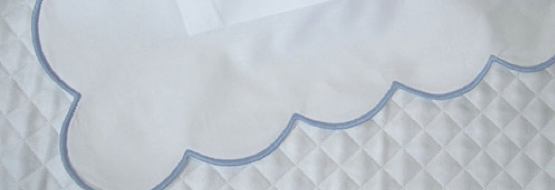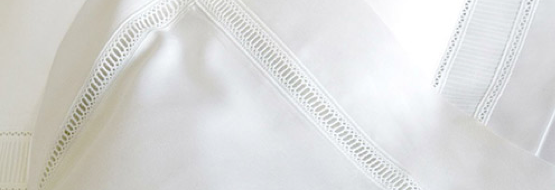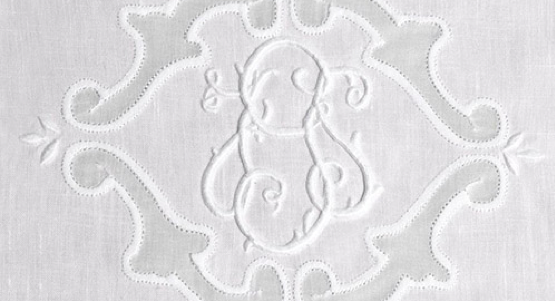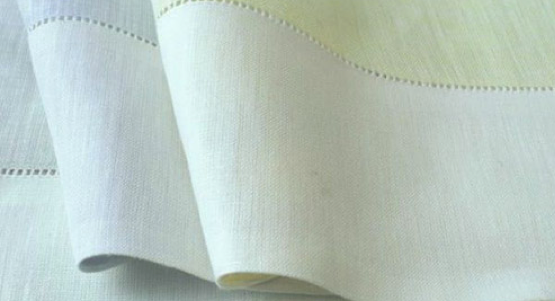Our Fabrics
Good quality bed linen will last you for many years and actually improves over time. This is why we only offer the finest quality linen.

How do you choose between all the different qualities on the market?
Your best bet, of course, is for you or your client to go and physically feel the different qualities for yourselves. And here I would like to give you a few guidelines about the different choices available on the market.
There has been a recent obsession with the thread count of cloth (e.g. the number of stitches per square inch), but it is not the thread count that matters most. The quality of the yarn and the finish of the fabric are much more important. These directly affect the softness and strength of the fabric. Don’t get obsessed by thread count and just accept that a thread count of 300 to 600 is optimal. Less is too little and more is probably not necessary.
To help you with your choice here are the main characteristics and differences between cotton percale, satin cotton and linen – which are the fabrics most fine bed linens are made of.
Cotton: Percale or Sateen Cotton
The two choices for cotton bed linen are percale and sateen cotton. These terms refer only to the type of weave used in the weaving process. Both percale and sateen are woven from cotton and can vary as to which country they are grown. High quality cotton yarn is spun from long staple fibres, this is vital in producing good quality yarn and from this you can produce good quality cotton.
The most famous of all is Egyptian cotton which is made from long staple fibres. The top five cotton-producing countries in the world are China, USA, India, Pakistan and Brazil. Our linens are made exclusively of fine long staple cotton.
Percale

Percale is a plain weave fabric, this is a simple one-over and one-under, 1:1 thread weave structure. This creates a matt, crisp appearance. Because percale threads are tightly woven, these sheets have a fine, soft, powdery texture and finish. Percale has a more durable weave than sateen, because of this simple weave, it is also less likely to snag or pill over time.
Sateen Cotton

Sateen cotton sheets have an elegant and luxurious look and feel. They are made by using a satin weave. The satin weave structure is a multiple thread weave usually two or four over, and one under, this results in a more lustrous, smooth-faced, silky surface. Better-quality sateen cotton sheets are differentiated from the lesser quality sateen by the length of the staple cotton used in the weaving as well as the finishing process.
Main Difference
Percale is matt and crisp looking and is better for summer or hot climates, it is slightly more durable than sateen cotton because of it construction. It feels soft and cool when you get into bed. Sateen cotton is silkier and more luxurious looking but less suitable for hot climates as it seems to store heat under its denser weave and is a better choice for winter or cold climates. It feels softer than percale, a bit more like silk because of its construction and finish.
Linen
Linen is one of the earliest products known to civilisation and was the earliest vegetable fabric to be woven. The first records of an established linen industry are 4,000 years old. It is considered the noblest cloth, both the purest and the strongest. It also has the advantage of acquiring extreme softness over time. Egypt, and later Ireland, are the two countries that come to mind in connection with the ancient history of linen.
Up to the 1950’s, Ireland, France, Italy and Belgium were considered the finest producers of flax. Now, it is also massively cultivated in China and East European countries as well as America. Irish linen may have been considered the Rolls Royce of linens because it was in Ireland that the first linen weaving industry in the 18th century was set up. Irish linen is generally heavier and denser than European linen. Portugal, Spain, France, Belgium and Italy produce beautiful linen and are most famous for their exquisite hand embroidery work. The Italians have mastered the dying of this fibre, which results in its extraordinary variety and depth of colour, unequalled on cotton. We mostly use Italian, Belgian and Irish linens for our bed linen and table linen.

The Main Qualities of Linen:
- The strength of the fibre: it is 2 or 3 times the strength of cotton
- It is considered by many to be the most ecological and healthiest material for sleeping in
- It is the epitome of coolness thanks to its temperature-regulating properties. In hot weather, linen absorbs moisture without retaining it thus avoiding excess heat, whereas in cold weather it retains heat thanks to the density of its fibres
- Its yarn is very smooth, making the finished fabric lint free, which gives it a wonderful lustre and sensuous feel. Linen gets softer every time it is washed
- Linen can be boiled and bleached, if absolutely necessary, to remove stubborn stains
- Linen has poor elasticity and does not spring back readily, explaining why it wrinkles so easily, but creased linen is now definitely in fashion, so if you want to give your linen a more contemporary look, don’t iron it!


